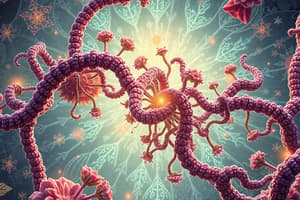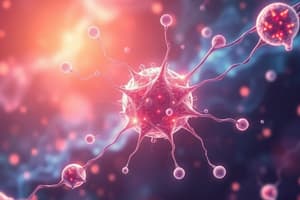Podcast
Questions and Answers
What does EC50 represent in a dose-response relationship?
What does EC50 represent in a dose-response relationship?
- The maximum effect of a drug
- The highest dose that can be administered safely
- The concentration at which 50% of the maximal effect is observed (correct)
- The lowest concentration required to initiate a response
What does a concentration-effect curve measure?
What does a concentration-effect curve measure?
- The response to a drug at a target site (correct)
- The safety profile of a drug
- The pharmacokinetics of a drug
- The interaction between two ligands
How can ligand B be characterized compared to ligand A according to the dose-response relationship?
How can ligand B be characterized compared to ligand A according to the dose-response relationship?
- Ligand B has the same efficacy but lower affinity than ligand A (correct)
- Ligand B has higher efficacy and lower affinity than ligand A
- Ligand B has higher efficacy and equal affinity to ligand A
- Ligand B has lower efficacy and higher affinity than ligand A
What is the primary distinction between affinity and efficacy in drug interactions?
What is the primary distinction between affinity and efficacy in drug interactions?
In the context of dose-response curves, what does Emax signify?
In the context of dose-response curves, what does Emax signify?
What role does the x-axis play in a logarithmic dose-response curve?
What role does the x-axis play in a logarithmic dose-response curve?
Which statement about potency is correct in the context of EC50?
Which statement about potency is correct in the context of EC50?
What does a dose-response relationship primarily describe?
What does a dose-response relationship primarily describe?
If ligand C has the same affinity as ligand A but lower efficacy, what can be inferred?
If ligand C has the same affinity as ligand A but lower efficacy, what can be inferred?
Which term is preferable to use when referring to anything a drug interacts with to cause an effect?
Which term is preferable to use when referring to anything a drug interacts with to cause an effect?
What do agonists do when they bind to receptors?
What do agonists do when they bind to receptors?
Which scientist is known for establishing receptor theory with the development of propranolol?
Which scientist is known for establishing receptor theory with the development of propranolol?
What is the affinity of a ligand?
What is the affinity of a ligand?
What do secondary allosteric binding sites influence?
What do secondary allosteric binding sites influence?
Which concept describes the relationship between affinity, efficacy, and effect?
Which concept describes the relationship between affinity, efficacy, and effect?
What does a receptor’s “orthosteric” binding site primarily bind?
What does a receptor’s “orthosteric” binding site primarily bind?
What is the main focus of receptor theory in pharmacology?
What is the main focus of receptor theory in pharmacology?
Who introduced the term ‘receptor’ into pharmacological theory?
Who introduced the term ‘receptor’ into pharmacological theory?
Which of the following statements about receptors is false?
Which of the following statements about receptors is false?
Flashcards are hidden until you start studying
Study Notes
Receptor Theory
- The term "receptor" comes from Ehrlich's "side chain" chemical bonding theory developed in immunology.
- Receptor theory, based on the idea that drugs bind to specific sites on cells to exert their effects, is fundamental to pharmacology.
- Langley proposed the chemical binding theory for all drugs in 1878 and 1905.
- Clark and Gaddum further developed receptor theory in the 1920s and 1930s.
- Sir James Black's work in 1965, specifically his discovery of propranolol, solidified the concept of receptors.
Drug Target vs. Receptor
- The term "drug target" is used to describe any molecule that a drug interacts with to cause an effect.
- "Receptor" is specifically used for proteins that recognize and respond to endogenous signaling mediators.
- Understanding drug-receptor interactions is crucial for understanding pharmacology.
Binding Sites
- Receptors have an active "orthosteric" binding site for their endogenous, activating ligand (agonist).
- Binding sites exhibit high specificity for endogenous agonists.
- Ligand binding induces conformational changes in the receptor, leading to activation.
- Receptors may also have secondary "allosteric" binding sites for other ligands.
Affinity and Efficacy
- Affinity quantifies a ligand's ability to bind to a target.
- Efficacy quantifies a ligand's ability to produce an effect once bound.
- Together, affinity and efficacy determine the potency of a ligand, which is its ability to generate a response.
Dose-Response Relationships
- Concentration-effect curves measure the effect of a drug at the target site.
- Dose-response curves measure the physiological response to a drug administered systemically.
- These curves are often plotted with the concentration or dose on a logarithmic scale.
Dose-Response Curves: Affinity and Efficacy
- The shape of a dose-response curve reflects the affinity and efficacy of a ligand.
- A higher affinity for a ligand is represented by a shifted curve to the left on the dose-response curve.
- A higher efficacy for a ligand is represented by a higher maximum response on the dose-response curve.
EC50 and Potency
- EC50 refers to the concentration at which a ligand produces half of its maximum effect.
- Potency, which is the concentration of drug required to cause an effect, is determined by the EC50 value.
- A lower EC50 indicates higher potency.
Studying That Suits You
Use AI to generate personalized quizzes and flashcards to suit your learning preferences.



